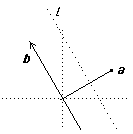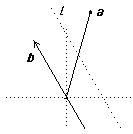Here is a complete classification of direct symmetries.
Theorem
Any direct symmetry is either a translation or rotation about some point.
Proof
- If f has a fixed point b then T-b∘ f ∘ Tb(0) = 0 and so this is a length preserving map which fixes the origin and hence is a linear map. Thus it is in SO(2) and is rotation about 0. Hence f is rotation about the point b.
- We have f = Ta∘ L with L ∈ SO(2) ⇒ f(x) = a + L(x). Now we try to solve f(x) = x = a + L(x) to find a fixed point. That is, we look for a solution of (L - I)x = -a. The only case in which we could not find such a solution is if L - I were not invertible. That is, if +1 were an eigenvalue of L. But the only element in SO(2) with +1 as an eigenvalue is the identity. Hence if f fails to have a fixed point, L = I and f is a translation.

We now classify the opposite symmetries. There are two kinds.
Theorem
An opposite symmetry of R2 is either reflection in any line or is a glide reflection.
Proof
Note that the reflection may be in a line not necessarily through 0.
A glide reflection (or glide) is a reflection in a line followed by a translation in a direction parallel to that line.
Since any element in O(2) - SO(2) is a reflection in a line through 0, the result follows from:
Lemma
Let Rb be reflection in a line through 0 containing the vector b. Then Ta ∘ Rb is a reflection if a and b are perpendicular and a glide-reflection otherwise.
Proof
 From the diagram, if a and b are perpendicular, then Ta ∘ Rb is reflection in the line l parallel to b through the point a/2.
From the diagram, if a and b are perpendicular, then Ta ∘ Rb is reflection in the line l parallel to b through the point a/2.
 If a and b are not perpendicular, then points of l are mapped to other points of l and so f acts on l by translation. Points on one side of l are mapped to the other side and so we have a glide along l.
If a and b are not perpendicular, then points of l are mapped to other points of l and so f acts on l by translation. Points on one side of l are mapped to the other side and so we have a glide along l.
